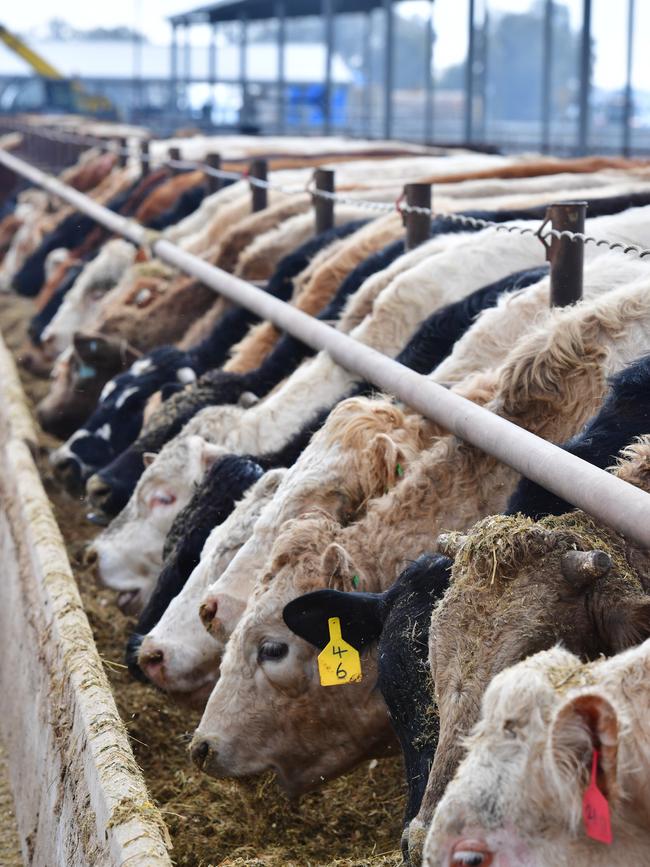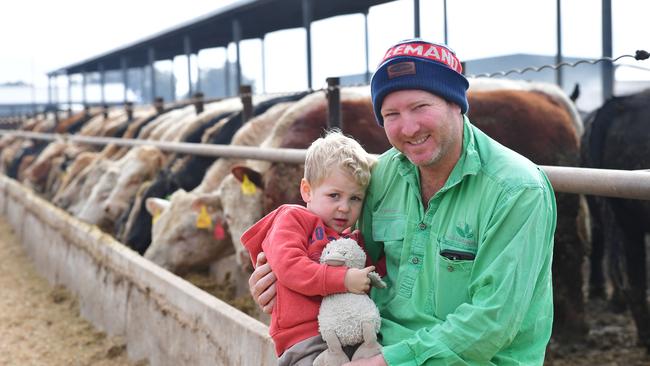Nanneella farmer Jason Palmer turns crops to profits with feedlot enterprise
Keeping crops on-farm and using feed grain in a feedlot is paying dividends for one Goulburn Valley family.
Using commodities produced on-farm to add value is paying dividends for a fodder operation at Nanneella in the Goulburn Valley.
Growing up learning about hay and silage contracting from his parents at Rochester gave second-generation farmer Jason Palmer enough of a taste of agriculture to decide it was his path, too.
Since 2003, he has developed an aggregation of about 1000ha across eight properties, where the Palmer family runs a cropping operation alongside a 1200-head feedlot, with plans to increase the acreage further.
Trading as Palmer Agricon, Jason and his wife, Kayla, and his parents, Thomas and Della Palmer, grow summer and winter crops and turn off beef cattle from the feedlot weekly.
They employ six people with additional seasonal employees for hay and fodder contracting.
Jason said the business had been on an expansion path, and he continued to grow the operation where possible, with crop performance in recent years good for equity.
Despite the current downturn in the beef cattle industry, he said there were still margins to be had, albeit with some challenging trading conditions at present.
The Palmers run an even-split cropping operation incorporating canola, wheat, lucerne and vetch. Lucerne and corn are grown as summer crops.
Ninety per cent of the acreage is under irrigation, with about 3500 megalitres of water sourced annually from the Goulburn-Murray Irrigation district in addition to on-property bores. “Irrigation helps to finish the crops off, and it allows us to be consistent,” Jason said.

VALUE-ADDING CROPS
The Palmers established a feedlot four years ago, in a bid to better control their returns.
“We were at a point in our business where everything we grew was sold off the farm, and I didn’t see that as sustainable for the longer term,” Jason said.
“I didn’t want to be at the mercy of the markets all the time.”
There were times when lucerne or hay was downgraded, and it didn’t necessarily fit a particular market. This meant that, like most producers in agriculture, the Palmers’ operation was impacted by external pricing.
“If your product doesn’t fit a market, you have to be a price taker, and it can be hard to sell,” he said.
Lower-grade hay, however, was an ideal input for the feedlot.
In addition to offering an additional year-round revenue stream, the feedlot was a valuable way to stop “exporting” produce from the farm and keep it within the system as a whole, Jason said.
Besides a small amount of canola meal and some mineral supplements, the feedlot doesn’t rely on any outside inputs.
“The feedlot is good for cash flow,” he said. “From all accounts, the beef job is going to pick up; there is a hiccup in pricing at the moment, but it will improve long-term.”
However, he said it was good to see grain prices where they were currently.

MAKING CROPS PAY
The feedlot and cropping operations run in unison, with cattle turned off weekly to provide handy cash flow.
The feedlot generally supports 1000 to 1200 mostly European crossbred cattle, primarily steers.
Each week, a load of finished cattle from the feedlot are sold directly to a wholesaler.
With the Eastern Young Cattle Indicator currently sitting at 443.74c/kg, Jason said things were tough for the beef industry.
“When you have a price declining like it is at the moment, it’s harder to make money but still possible,” he said.
“The margins are tight enough at the moment, but we ride the ups with the downs, there hasn’t been a tougher time to feed cattle.”
Despite extensive flooding hitting the Palmers’ properties in October last year, canola emerged as the shining light, with some crops yielding more than four tonnes a hectare.
“Our wheat was hit hard because it was very wet. We had paddocks that were completely written off,” Jason said.
Water was continually spilling over from the irrigation channels at Rochester and entering the system.
Crops are sown using a 22cm or 9-inch row configuration, with Jason planning to increase that to a 10-inch spacing to better suit a seeder that is being used.
“The whole system is sown using that configuration at the moment,” he said.
Sowing begins in the first week of April, regardless of the weather.
Currently, his crops are looking good and have benefited from early-season urea application.
Despite widespread shortages of the nitrogen fertiliser, Jason said he was fortunate to secure urea before supplies got tight, and it was applied in May.
So far, the property has received 340mm of rainfall for the calendar year. The average annual rainfall is 460mm.
Although last year’s wet season is still a strong memory, Jason said crops were in need of a drink at the moment.
“We could do with some rain this month,” he said.
Canola harvest will start during the last week of November, and the aim is to be completed by Christmas.
The winter crop and summer crop activities occur almost in unison.
There is also hay and silage making, and most of the lucerne from the summer crop operation is destined for chaff mills. The vetch is used in the feedlot.
The whole operation relies on being able to store grain and fodder on the farm.
The property currently has about 2000 tonnes of storage with plans for more.
“This is something we are developing,” Jason said.
“I’m currently designing a grain shed.” Jason said fertiliser, feed, chemicals, electricity, labour, fuel and machinery all contributed to the cost of running the business, with no single input standing out.
CIRCULAR ECONOMY
In addition to extracting more value from his crops, Jason is on a mission to put feedlot waste to productive use in his farming system.
For the past five years he has applied manure to paddocks as part of a long-term plan to increase yields, and it is continually helping to improve the black self-mulching soil that is dominant across the properties he farms.
Initially, he was purchasing truckloads of chook manure to incorporate valuable nutrients back into the soil.
It turned out to be an expensive exercise, and the logistics involved with transport added up. At the time, bulk chicken manure cost about $10 to $15 a cubic metre.
Last year he swapped to using manure from his feedlot, with about 5000 tonnes spread directly on to paddocks.
While it’s early days, he expects the practice to help reduce fertiliser costs in the future.
“Once you have manure history on the paddocks, it starts to pay its way,” he said.
“It’s my theory that we will see much better yields.”




